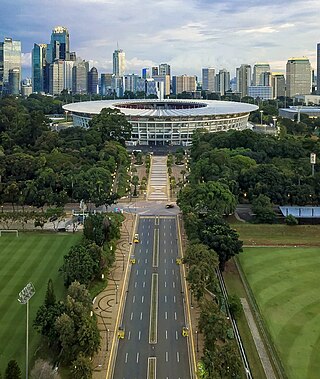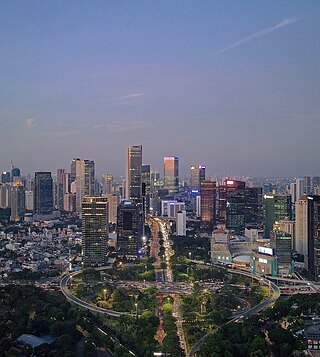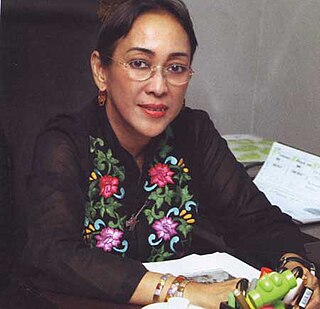
Palembang is the capital city of the Indonesian province of South Sumatra. The city proper covers 352.51 square kilometres on both banks of the Musi River in the eastern lowlands of southern Sumatra. It had a population of 1,668,848 at the 2020 Census; the official estimate as at mid 2023 was 1,772,492. Palembang is the second most populous city in Sumatra, after Medan, and the twelfth most populous city in Indonesia.

Sukarno was an Indonesian statesman, orator, revolutionary, and nationalist who was the first president of Indonesia, serving from 1945 to 1967.

Padang is the capital and largest city of the Indonesian province of West Sumatra. It had a population of 833,562 at the 2010 Census and 909,040 at the 2020 Census; the official estimate as at mid 2023 was 942,938 - comprising 473,089 males and 469,849 females. It is the 16th most populous city in Indonesia and the most populous city on the west coast of Sumatra. The Padang metropolitan area is the third most populous metropolitan area in Sumatra with a population of over 1.7 million. Padang is widely known for its Minangkabau culture, cuisine, and sunset beaches.

Gelora Bung Karno Main Stadium, formerly Senayan Main Stadium and Gelora Senayan Main Stadium, is a multi-purpose stadium located at the center of the Gelora Bung Karno Sports Complex in Central Jakarta, Indonesia. It is mostly used for football matches, and usually used by the Indonesia national football team and Liga 1 club Persija Jakarta. The stadium is named after Sukarno, the then-president of Indonesia, who sparked the idea of building the sports complex.

Gelora Bung Karno Sports Palace, is an indoor arena located in Gelora Bung Karno Sports Complex, Jakarta, Indonesia. The capacity of the arena after 2018 reopening is 7,166. This arena is usually used for badminton tournaments, especially the BWF tournaments Indonesia Open and Indonesia Masters. The first event that held in this arena was the 1961 Thomas Cup.

The 1962 Asian Games also known as the 4th Asian Games, IV Asiad, and Jakarta 1962, was the fourth edition of pan-Asian multi-sport event sanctioned by the Asian Games Federation (AGF). The games were held from 24 August to 4 September 1962, in Jakarta, Indonesia. It was the first international multi-sport event hosted by the then-17-year-old Southeast Asian country. This was the first of two Asian Games hosted by the city: the second was held in 2018, with Palembang as the co-host.

Gelora Sriwijaya Stadium, also known as Jakabaring Stadium, is a multi-purpose stadium located in Jakabaring Sport City complex in Palembang, South Sumatra, Indonesia. Holding 23,000 spectators., the stadium is currently used mostly for football matches. The construction began in 2001 and finished in 2004 to host the 2004 Indonesia National Games. The stadium was initially named as Jakabaring stadium after the location of the stadium in southern outskirt of Palembang. However, later the stadium was renamed "Gelora Sriwijaya", to honor and celebrate the 7th—13th century Indonesian empire of Srivijaya. The Third Place Playoff of the 2007 AFC Asian Cup was held in this stadium. The football club Sriwijaya is based at the stadium.

The Sunda Strait Bridge was a planned road and railway megaproject between the two large Indonesian islands of Sumatra and Java.

The capital of Indonesia, officially the capital of the Unitary State of the Republic of Indonesia, is Jakarta, one of the oldest continuously inhabited cities in Southeast Asia. However, since the enactment of the Special Region of Jakarta Act, Jakarta has lost its de jure status as capital of Indonesia, and is currently in a transitional period due to the relocation of the capital to Nusantara.

Gelora Bung Karno Sports Complex (Indonesian: Kompleks Gelanggang Olahraga Bung Karno, formerly named Senayan Sports Complex from 1969 to 2001. This sports complex is located in Gelora, Central Jakarta, bordering the Senayan, South Jakarta because of its large location. This sports complex was a brain child of Sukarno, the first President of Indonesia, in order to host the 1962 Asian Games. This sports complex consists of a main stadium, secondary stadium, the Sports Palace, football fields, aquatic stadium, tennis stadiums, hockey, baseball and archery fields, and several indoor gymnasiums. This complex was built in 1960 and underwent major renovation for the 2018 Asian Games and Asian Para Games.

The Ganting Grand Mosque is a Sunni mosque located in Ganting, Padang, West Sumatra, Indonesia. Construction began in 1805, making it the oldest in Padang and one of the oldest in Indonesia. It is a Cultural Property of Indonesia.

Jalan M.H. Thamrin or Jalan Thamrin is a major thoroughfare in Jakarta, Indonesia. The road is located at the center of Jakarta, running from the north end of Jalan Jenderal Sudirman at West Flood Canal at the south end to the roundabout near Arjuna Wijaya Statue Jakarta at the north end. Developed in the 1950s, the road was a landmark of post-colonial Indonesia and continues to have a prominent importance in Jakarta.

Sidarto Danusubroto is an Indonesian politician and a retired police officer, who is serving as a member of Indonesia's Presidential Advisory Board. A member of the Indonesian Democratic Party of Struggle, he previously served as speaker of the People's Consultative Assembly, from 2013 until 2014, following the death of Taufiq Kiemas.
The 2014 ASEAN University Games, officially known as the 17th ASEAN University Games, was a Southeast Asian university multi-sport event held in Palembang, Indonesia from 11 to 21 December 2014.

De-Sukarnoization, also spelled de-Soekarnoization, was a purging policy that existed in Indonesia from the transition to the New Order in 1966 up to the beginning of the Reformation era in 1998, in which President Suharto intended to defame his predecessor Sukarno as well as lessen his presence and downplay his role in Indonesian history.
Palembang is the capital city of South Sumatra province of Indonesia. Currently, this city is the oldest existing city in Indonesia, dates back to 7th century. Palembang was once the capital city of Srivijaya, a Palembang empire which ruled parts of the western archipelago and controlled maritime trade routes especially in the Strait of Malacca. Palembang incorporated into Dutch East Indies in 1825 after the abolishment of Palembang Sultanate. Palembang is chartered as a city on 1 April 1906. Palembang today is the second largest city in Sumatra and the ninth largest city in Indonesia. The city has become host of several international events, including 2011 Southeast Asian Games and 2018 Asian Games.

Semanggi Interchange or commonly known as Semanggi Bridge is a major road interchange in Jakarta, Indonesia which consists of a cloverleaf interchange —the first, and until the 1990s the only, of its kind in Indonesia—and a partial turbine interchange. Two main roads of the city Gatot Subroto Road and Sudirman Road intersect at this interchange. Initially completed in 1962 as part of several projects intended to be completed before the 1962 Asian Games, the interchange is a landmark and an important part of the Golden Triangle of Jakarta.

Diah Mutiara Sukmawati Sukarnoputri is the third daughter of Indonesia’s founding president Sukarno and his wife Fatmawati. Sukmawati is the younger sister of former Indonesian president Megawati Sukarnoputri and politician Rachmawati Sukarnoputri.

The Grave of Sukarno, Indonesia's first president, is located in Blitar, East Java. Initially an ordinary grave where he was buried shortly after his death, a mausoleum was constructed in the late 1970s and the site evolved into a political and religious pilgrimage site, receiving hundreds of thousands of visitors annually.


















